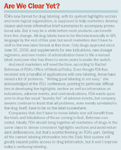Washington Report: Waiting for Advice
Pharmaceutical Executive
Long turnaround on ad reviews adds new complications to the process of developing marketing plans.
FDA is having a tough time overseeing promotional activities and providing timely advice on proposed advertising materials. It now takes an average 45 to 50 days for the Division of Drug Marketing, Advertising and Communication (DDMAC) in the Center for Drug Evaluation and Research (CDER) to review drug launch materials. Advice on planned broadcast ads can take 80 days. Time frames like these create problems for marketers who want FDA's opinion before they revise TV commercials and brochures—and they're a nightmare in planning launch campaigns.

Jill Wechsler
Is FDA building a case for tapping user fees to support a bigger DDMAC staff? Agency officials won't admit to such a strategy, but in the future companies may have to ante up for more timely assessment of promotional materials. Such proposals are evidently on the negotiating agenda as the agency prepares for the renewal of the Prescription Drug User Fee Act (PDUFA) next year.
Speaking in September at the Food and Drug Law Institute (FDLI) conference on FDA advertising and promotion, DDMAC director Tom Abrams acknowledged that it was taking a long time to review drug marketing materials. Submissions to DDMAC are up sharply, and the mix includes a greater number of biotech products and drugs to treat complex medical conditions; promotional materials for these sorts of products require lengthy deliberations by multiple staffers, Abrams explained. The office is also monitoring thousands of Web sites, as well as a broad range of brochures, direct-mail pieces, and videos.
Ad reviewers at the Center for Biologics Evaluation and Research (CBER), which oversees marketing of blood products, vaccines, and some combination products, report a similar time frame for providing advice on marketing materials. On average it takes 30 to 50 days to issue an advisory opinion on a DTC ad, reported branch chief Ele Ibarra-Pratt.
More Submissions
DDMAC received almost 55,000 promotional pieces in 2005, up from 40,000 in 2003. Most (about 40,000 items) were designed for professional audiences. About 10,000 were directed to consumers, and some 6,000 involved Web sites serving both audiences. DDMAC was asked to review 337 broadcast ads last year. That is actually about 100 fewer than in 2004, but more than previous years.

Are We Clear Yet?
The numbers don't tell the whole story, however. Ten years ago, few product launches involved consumer advertising, and many submissions made just slight revisions to existing ads, explained Melissa Moncavage, leader of DDMAC's DTC review group. Today, most DDMAC filings contain totally new materials, and biotech companies are beginning to run TV ads for complex new therapies.
DDMAC similarly received fewer requests for advice on broadcast commercials (146 proposals in 2005, compared with around 200 in previous years), but the process of providing advisory opinions is still resource-intensive. DDMAC takes a team approach, says Moncavage, bringing in medical reviewers and other CDER officials to review consumer ads for innovative products.
DDMAC is reorganizing to add a second DTC review group to deal with this rising workload. The change adds only one new reviewer, but the agency hopes that the presence of two group leaders —Moncavage and Christine Smith—will reduce the bottleneck on advisory opinions. The two groups will continue to examine print ads, brochures, and physician hand-outs, in addition to TV commercials, and to encourage marketers to seek agency advice on proposed ads. (Submission is voluntary, except for products that qualify for accelerated approval.)
The long turnaround time on advertising reviews, however, adds a new complication to the process of developing marketing plans, pointed out Wayne Pines of APCO Worldwide. DDMAC puts launch materials, DTC ads, risk-management plans, and accelerated-approval products at the top of its review priority list; conversely, something like a new sales aid can take weeks to get any attention.

Advising the Feds
Delays create particularly acute problems for companies bringing new products to market. DDMAC usually doesn't begin looking at marketing materials for new drugs until CDER approves final labeling, and this often is the last thing decided in the NDA review process.
Waiting for New Rules
The flood of promotional materials makes it difficult for DDMAC staff to develop the many new guidances and rules on its to-do list. The agency received more than 1,200 comments on how FDA should regulate DTC advertising following a public hearing in November 2005. But officials have yet to decide if FDA needs to revise its advertising regulations, issue additional guidance, or leave things the way they are.
Another long-discussed topic is how FDA should revise its requirements for a "brief summary" of prescribing information. FDA held a public meeting on the issue three years ago and issued draft guidance in January 2004. Then it decided to do more research on how brief summaries are actually used andwhat options were available for improving their format and content. DDMAC is just now launching a survey to find out which sections of brief summaries are most useful to consumers. Additional studies will seek public opinions on ways to design and write this information to make it more comprehensible.
Regulating Risks
One new guidance that might appear sooner, rather than later, will advise marketers on appropriate ways to present risk information.
Abrams said this is a high-priority area because marketers continue to push the envelope in emphasizing benefits and minimizing risks. FDA is struggling to bring compliance to this area, Abrams commented, pointing to the prevalence of warning letters that cite pharmaceutical marketers for misleading presentation of safety issues and warnings in promotional materials.
DDMAC is issuing more warning letters overall (13 in recent months compared with five in comparable previous periods). And where warning letters were traditionally outnumbered by less serious "untitled letters," the reverse is now true. Marketers have been cited for overstating drug effectiveness and making misleading comparative claims, but the top concern is understating risk.
Recent warning letters, for example, cite failures to explain the serious risks of diabetes and other complications related to anti-psychotic drugs and to describe the potential for serious side effects from a new varicose-vein injection. The new draft guidance, which Abrams hopes will be out by year-end, aims to prompt marketers of all FDA medical products to pay the same attention to risk information as to benefits.
Jill Wechsler is Pharm Exec's Washington correspondent. She can be reached at jwechsler@advanstar.com

FDA Approves Opdivo Plus Yervoy Regimen for MSI-H/dMMR Colorectal Cancer
April 9th 2025Approval of the Opdivo plus Yervoy combination regimen was based on results from the Phase III CheckMate-8HW trial, which was the largest immunotherapy study in patients with previously untreated, unresectable, or metastatic microsatellite instability-high or mismatch repair deficient colorectal cancer.
The Misinformation Maze: Navigating Public Health in the Digital Age
March 11th 2025Jennifer Butler, chief commercial officer of Pleio, discusses misinformation's threat to public health, where patients are turning for trustworthy health information, the industry's pivot to peer-to-patient strategies to educate patients, and more.